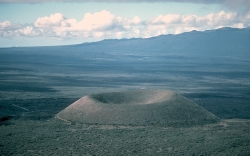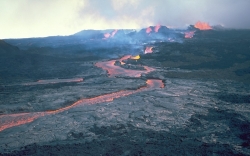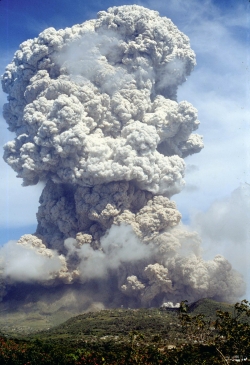Paint a picture of a volcano for me. Now let's see what you came up with. It looks like a mountain with a hole in the top that shoots fire and ash into the air. Here are some villages at its base with people running away. This is what a lot of people think a volcano looks like, but do all of them look like this? Let's go on a volcano hunt and find out. After all, volcanoes are like windows. They give us a look into what's going on inside the Earth.
There! Far away, that looks like a volcano. It doesn't have any smoke coming out of its top, so I think it's safe to check it out. As we get closer, you will see it is not as big as the one in your picture. A
cinder cone volcano is a small hill with steep sides made of pieces of rock. Think of an anthill. It's steep and is made of little pieces of dirt the ants carried out as they dug. With cone volcanoes, rocks and bits of cooled lava blow out of the top, break apart in the air and then fall to make a hill. Because those rock pieces roll down, the hill does not become very big. Cones only grow a few hundred feet tall, which is about as tall as most buildings in a city. This doesn't mean cone volcanoes are not dangerous though. Those rocks can blow out of the top like cannonballs and fall far away, hitting places where people live.

I see the hill. Where did the ants go?
J.P. Lockwood, USGS employee, Public domain, via Wikimedia Commons
Now what about the lava in your picture, you ask? Let's keep hunting.
We will walk up this easy path and see if we can spot the biggest of all volcanoes. On our way up, I'll tell you some facts about them. The lava from this kind runs like water, so it goes farther. Also, many small islands are made volcanoes like these! Ah. We made it to the top. Do you see it? No? That's because we're standing on it! How could we have walked to the top of the biggest volcano and you did not even know? Not everything that's big is tall.
Shield volcanoes are the largest, flattest volcanoes. They have lava that is like water that flows out of them over time. They are kind of flat like pancakes and stretch out for three or four miles. Not only is it easy to climb them, but you could run away from the lava because it only moves about two miles an hour.

Things can get a little hot at the Mauna Loa volcano in Hawaii.
Photo by R.W. Decker., Public domain, via Wikimedia Commons
Where are volcanoes like the one in your picture? Oh! There's one, making a shadow over the valley. What makes a volcano really tall? You could take parts of the other two types and put them together. A
composite volcano is made of both rock pieces and cooled lava flows. They have very steep sides at their tops because their lava is like honey that sticks to the sides where it cools into rock. These are the kind of volcanoes that look like the one in your picture, sending out hot rivers of ash and gas, killing everything in their paths. These lava rivers can move up to 125 miles an hour and go as far as 60 miles away! These volcanoes can grow to be 8,000 feet tall! Now that's more like it.
So if volcanoes are like windows, what do they tell us about the middle of our Earth? An
eruption is when lava flows out of a volcano. It can be flowing very fast or very slow, but the name for it is the same. It helps that the Earth spits out parts of its center so we can see what it's made of and how it acts. The first thing we can learn is that the middle of our Earth is hot. The fact that it shoots out so fast must mean there's a lot of pressure down there. Last but not least, volcanoes teach us that there are parts of the Earth's crust that do not connect! In some of these places, we can see lava escape. This also leaves us with a lot more questions. Like, how did the outside of our Earth break in the first place?

Boom goes the volcano!
Sometimes we are lucky enough to watch the Earth build a volcano before our very eyes. Lava or rocks or both shoot out of the Earth and make hills small, flat, or very large. Some take only a few months to make. Others take thousands of years. There are quiet volcanoes and there are loud ones. The next time you draw a volcano picture, think of the different kinds, and then think of where all that lava comes from . . .
References:USGS. "Principal Types of Volcanoes." USGS, 2011. <http://pubs.usgs.gov/gip/volc/types.html>
Facweb. "Types of Volcanoes." St. Vincent, 2012 .<
http://facweb.stvincent.edu/academics/pathways/science/volcanoes.htm>